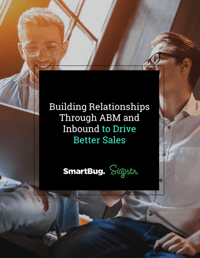
Marketing is ever-evolving, due to new technologies and the shifting needs of prospective customers. The methods that reeled in prospective buyers a decade ago aren’t meeting the needs of modern buyers.
Today’s consumers are inundated with content, and anything they’re interested in buying is a search engine query away. How do we meet our buyers where they are? How can marketers build trust and reach the perfect audience?
It’s time to talk methodologies and balance.
Differentiating Outbound, Inbound, and ABM Marketing
Outbound Marketing Strategy
Outbound marketing is what people traditionally think of when someone says they work in marketing. Outbound marketing works by casting a wide net to its audience, meaning that any audience that can be reached will be reached. Commercials, banner ads, billboards, and print advertising are all examples of outbound marketing.
Outbound marketing is becoming less effective as time goes on, and that’s because outbound marketing doesn’t have a specific focus in terms of who is seeing marketing efforts. With the advent of ad blockers, filters, and asking users to pay just a little bit more for commercial-free experiences, users are sending a clear message to companies: Stop interrupting the experience. However, outbound marketing is not necessarily a bad thing (more on that later).
Inbound Marketing Strategy
Now let’s touch on inbound marketing. Whereas outbound marketing focuses on getting a message out to everyone, inbound marketing focuses on being found by the ideal audience and building trust. Inbound marketing is a more strategic approach that focuses on the customer as a person.
Also known as content marketing, inbound marketing methods include blogging, social media messaging, opt-in marketing, and being at the top of a prospect’s search engine results. Ideally, once a lead comes to a company’s website, they’re already interested in the products and services, but they want to learn more about the company and whether the company best fits what they need.
Think about buying a car: Customers walk into a dealership knowing what they can afford, and they have an approximate idea of the type of vehicle they want based on background research. The dealership’s job is to then show the ideal cars for the customer.
In essence, inbound is simply nudging a customer down the sales funnel by educating the prospect and creating trust in the brand. Inbound marketing is a popular methodology because of its longevity and overall value proposition to the buyer.
So, how can we get the best of both worlds? By using a systematic strategy that includes inbound and outbound methodologies working together to create solid and measurable campaigns. A great example of driving a balance between inbound and outbound is running an account-based marketing (ABM) campaign.
ABM Marketing Strategy
ABM campaigns are thoughtfully created by sales and marketing teams working together. During planning sessions, teams pick the “ideal customer” and create a campaign targeting them with both sales and marketing tactics. This omnichannel approach highlights the customer’s challenges and creates a campaign to solve them.
ABM increases the velocity of the Buyer’s Journey through personalization, so they convert quickly. ABM takes the human-centered approach of inbound, the value proposition of outbound, and creates a message that resonates with the customer a company is trying to target.
Let’s go back to the car buyer: Before they even step into the dealership, they’re researching their budget and the type of car they want. Maybe they’ve heard great things about the Honda CR-V, so that’s what they want to see. But is that the only brand of safety-rated crossover on the market? Of course not. In this case a manufacturer like Mazda can leverage that interest and direct it to their CX-5. ABM marketing works by identifying the specific needs of the prospective buyer and creating a targeted campaign that is delivered directly to them.
How Do Inbound, Outbound, and ABM Work Together?
If we take components of both inbound and outbound methodologies, we can then create a balance that results in a stellar ABM strategy. Although outbound marketing is interruptive and not the most effective marketing strategy on its own, there are components that create the message. It’s important to remember that the focus of ABM is taking an omnichannel approach. That is to say, companies target their ideal customer from all sides: inbound campaigns that build trust, paid advertising (both digital and outbound), sales calls, emails, and so forth.
To truly harmonize and create a great ABM strategy, inbound marketing tactics are crucial. Because inbound marketing focuses on high-value content being delivered to the audience, it’s vital that an organization knows the audience. Inbound is focused on an educational experience: no gimmicks, no interruptions, only subtlety.
Therefore, it can be said that ABM is simply a strategy that uses both inbound and outbound methodologies to rev up the Buyer’s Journey in a way that creates a great user experience and provides more insightful ROI to organizations.
Strategies for Achieving a Balance Between Inbound and Outbound for Your ABM Strategy
If there is one important message to take from this, it’s that applying inbound and outbound doesn’t mean companies have to reinvent the wheel. Remember that ABM works to engage and delight customers by getting down to the heart of what your customers want. Inbound-backed strategy means that the same high-value content an organization creates regularly can be repurposed and personalized even more to a target audience.
Outbound-fueled prospective client identification can help find the ideal customers to target with your ABM strategy. This means cold calling and reaching out to learn more about prospective buyers. Outbound ultimately creates 1:1 interactions to deliver a customer through the Buyer’s Journey, which is the goal of a successful ABM campaign.
Creating an ABM Strategy
When inbound and outbound work together to create an ABM strategy, the overarching theme will be a campaign that is thoughtful, targeted, and measurable. ABM strategy works by aligning sales and marketing teams to get the message to the ideal customer and close the deal. By combining inbound and outbound methodologies to create an ABM strategy, the overall result will truly be the right content delivered to the ideal audience at the right time throughout the Buyer’s Journey.
So, how does it all come together?
- First, you’ll need to map out your ideal clients: the cream of the crop that you’ll do just about anything to grab the attention of and land a deal. Please note that this list should be fairly short and specific.
- Once you’ve compiled this data, create a list of accounts that fit your ideal clients and include their specific company details along with your points of contact.
- Finally, you need to analyze that list and nail down the attributes, behaviors, and commonalities of your targeted clients.
- From there, it’s easy to collaborate to provide compelling content and messages that resonate with the identified clients.
For example, let’s say a software company is targeting buying executives and the people using their solution at Acme, Inc. The software company was able to identify their ideal customers at Acme, Inc. via outbound marketing, such as targeted ads and cold calling. Then they would need to tailor a unique and personalized campaign with inbound methodologies.
The company will create an ABM campaign uniquely suited to the individuals at that company. In the lead nurturing deliverables, the software company would create highly personalized messaging, such as Acme, Inc., branding, or personalization tokens around job titles. When the prospects see their personalized message, they feel like the company “gets” them.
Targeted Relationship-Building Closes Deals
The marketing industry will always be an ever-evolving and improving mechanism that redefines itself to meet the needs of customers. This is an absolute win for the companies striving to keep their message relevant to the masses over time.
Outbound, inbound, and ABM strategies are simply the next step in meeting the needs of the customer, which is the ultimate goal. Remember, regardless of methodology, it’s crucial that relationship-building is at the core of the journey.
For more information on building relationships through ABM and inbound to drive better sales, check out our e-book, Building Relationships Through ABM and Inbound to Drive Better Sales.

About the author
Brittany Glasscock was formerly a Marketing Specialist at SmartBug based in The Woodlands, Texas. She started her career in the K-12 industry and transitioned into content marketing for a B2B SaaS company. When she's not rocking awesome inbound strategies for clients, she runs (poorly), travels as much as possible, and tries not to burn her kitchen down while cooking. Read more articles by Brittany Glasscock.
















![[FREE EBOOK] Weave ABM Into Your Inbound Strategy](https://no-cache.hubspot.com/cta/default/142915/db8a46d5-388f-47e9-b0c7-d5083355741d.png)





